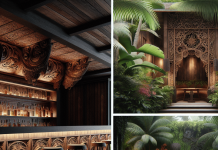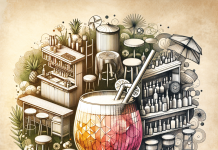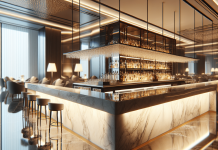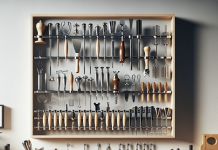Glass is a versatile material that plays an integral role in everyday life, yet we rarely stop considering its different types and unique characteristics.
From the shimmering brilliance of float glass to the sturdy strength of tempered glass, this article will take you on a journey through the fascinating glass world.
So, please fasten your seat belts and get ready to explore the four types of glass that have revolutionized countless industries and captured our imaginations.
Float Glass
What is Float Glass?
Float glass is a type of glass that is widely used in the construction and automotive industries. It is a clear, flat glass with excellent optical clarity and smoothness. Float glass is made by floating molten glass on a molten tin bed, resulting in a smooth and uniform surface. This manufacturing process allows the glass to be produced in large sheets, making it highly versatile and suitable for various applications.
How is Float Glass Made?
The process of manufacturing float glass begins with melting raw materials such as silica sand, soda ash, dolomite, limestone, and salt cake in a furnace at extremely high temperatures. Once the raw materials melt and form a molten glass, it is carefully poured onto a bed of molten tin, which is maintained at a specific temperature.
As the glass flows onto the molten tin, it spreads out, forming a flat, even sheet. The molten glass then undergoes a controlled cooling process, solidifying and stabilizing its properties further. Once cooled, the glass is carefully lifted, cleaned, and cut into large sheets of float glass.
Applications of Float Glass
Float glass’s versatility and excellent optical properties make it suitable for various applications. It is commonly used for windows, doors, facades, and partitions in the construction industry. Its flat, transparent surface allows maximum natural light transmission, creating bright and welcoming spaces.
Float glass is also widely used in the automotive industry for windshields, windows, and mirrors. Its high strength and durability make it ideal for withstanding the rigors of daily use and providing clarity and visibility for drivers.
Moreover, float glass can be further processed and treated to enhance its functionality. It can be coated with low-emissivity coatings for improved energy efficiency or tempered to increase strength and safety. Float glass can create a multi-functional unit with enhanced thermal and acoustic performance when combined with other types of glass, such as laminated or insulated glass.
Float glass’s versatility and adaptability make it popular for architects, designers, and manufacturers seeking high-quality glass solutions. Its widespread availability and cost-effectiveness make it a go-to option for various applications across different industries.
Tempered Glass
What is Tempered Glass?
Tempered glass, also known as toughened glass, is a type of glass that undergoes a unique heat treatment process to increase its strength and safety properties. It is approximately four to five times stronger than annealed glass and can resist higher impact forces.
The main characteristic of tempered glass is its ability to shatter into small, granular pieces when broken, reducing the likelihood of severe injuries compared to sharp shards of regular glass. This property results from the internal stresses induced during the tempering process.
How is Tempered Glass Made?
The production of tempered glass involves several steps. First, the glass is cut into the desired size and shape. Then, it undergoes a heating process at high temperatures, followed by a rapid cooling process known as quenching. This rapid cooling creates high compressive stresses on the surface of the glass.
The combination of heat and rapid cooling alters the internal structure of the glass, resulting in increased strength. The outer surface of the glass contracts more quickly than the inner portion during the cooling process, creating compressive stresses on the surface and tensile stresses in the core. This tension and compression balance gives the tempered glass its characteristic strength.
Advantages of Tempered Glass
Tempered glass offers several advantages over other types of glass. Its increased strength makes it highly resistant to impact, making it a safer option for applications where safety concerns it. For example, it is commonly used for glass doors, shower enclosures, and vehicle windows.
In addition to its strength, tempered glass can withstand high-temperature differentials, making it suitable for applications where thermal stress may be a factor. This property is ideal for ovens, fireplace doors, and glass cookware.
The characteristic shattering pattern of tempered glass is also advantageous regarding safety. When tempered glass breaks, it forms small, granular pieces rather than sharp shards, significantly reducing the risk of severe injuries.
Furthermore, tempered glass is highly resistant to scratches and general wear and tear, increasing its durability and longevity. Its resistance to thermal stress and chemical corrosion ensures that it maintains its integrity and performance over time.
Laminated Glass
What is Laminated Glass?
Laminated glass is a type of safety glass comprising two or more layers of glass bonded with an interlayer, commonly made of polyvinyl butyral (PVB) or ethylene-vinyl acetate (EVA). The interlayer is a strong adhesive, holding the glass layers together even when broken.
The primary characteristic of laminated glass is its ability to retain its structural integrity even when shattered. Unlike other types of glass that break into sharp and potentially hazardous shards, laminated glass remains intact due to the interlayer, significantly reducing the risk of injuries.
How is Laminated Glass Made?
The manufacturing process of laminated glass involves several steps. First, the glass layers are cut to the desired size and shape. The interlayer material, typically a PVB or EVA sheet, is placed between the glass layers.
The glass and interlayer stack is then placed in a vacuum bag and sent to an autoclave, where heat and pressure are applied. The heat causes the interlayer to soften and bond with the glass layers, forming a strong and durable laminated glass unit.
Once the lamination process is complete, the laminated glass is inspected for quality, and any imperfections or air bubbles are carefully addressed. The final product is a transparent, robust glass unit with enhanced safety and security properties.
Benefits of Laminated Glass
Laminated glass offers numerous benefits, making it a popular choice for various applications. One of its primary advantages is its ability to provide increased safety. When impacted, the interlayer holds the shattered glass together, preventing it from scattering and minimizing the risk of injuries from sharp glass shards. This makes laminated glass ideal for applications such as overhead glazing, skylights, and hurricane-resistant windows.
In addition to its safety features, laminated glass provides excellent sound insulation properties. The interlayer acts as a dampening material, reducing noise transmission and creating a quieter and more comfortable environment. This makes it beneficial for buildings in noisy areas or spaces requiring privacy, such as offices or conference rooms.
Laminated glass also offers protection against UV radiation. The interlayer can block harmful UV rays, reducing the risk of furniture and other items fading or deteriorating over time. This makes laminated glass suitable for use in areas exposed to direct sunlight, such as storefronts or residential windows.
Furthermore, laminated glass provides security benefits. Its strong and resilient nature makes it more difficult to penetrate, acting as a deterrent against break-ins and vandalism. It is often used in applications that require increased security, such as banks, museums, and jewelry stores.
Annealed Glass
What is Annealed Glass?
Annealed glass, or float glass, is the most basic form. It is the result of the float glass manufacturing process described earlier, where molten glass is poured onto a bed of molten tin and slowly cooled.
Properties of Annealed Glass
Annealed glass is characterized by its relatively low strength and lack of safety features. Unlike tempered or laminated glass, annealed glass undergoes no specific treatment or alteration to enhance its strength or safety properties.
One key property of annealed glass is its tendency to break into sharp, jagged shards when shattered. This poses a risk of injuries, especially in impact or collision scenarios. As a result, annealed glass is not recommended for applications where safety is a primary concern.
However, annealed glass does have its advantages. Its relatively low manufacturing cost makes it a cost-effective option for specific applications where safety is not a significant factor. It is commonly used for picture frames, interior glass panels, and decorative purposes where the risk of impact or breakage is minimal.
Common Uses of Annealed Glass
Due to its lower strength and safety properties, annealed glass is unsuitable for applications where safety is paramount. However, it still uses it in areas with minimal safety concerns.
Annealed glass is commonly used for residential windows in areas where building codes do not explicitly require safety glass. It is also used for interior glass partitions, shelving, and tabletops. In situations where aesthetics are the primary consideration, such as picture frames or decorative glass, annealed glass can be an appropriate choice due to its clarity and versatility.
While annealed glass may not possess the safety features and strength of other types of glass, it remains a viable option for certain applications where safety concerns are minimal, and cost-effectiveness and aesthetics play a more significant role.
In conclusion, the four types of glass – float glass, tempered glass, laminated glass, and annealed glass – each offers unique properties and advantages for a wide range of applications.
Float glass provides versatility and uncompromised optical clarity. In contrast, tempered glass offers increased strength and safety. Laminated glass excels in safety and security, and annealed glass serves well in applications where safety concerns are minimal and cost-effectiveness and aesthetics are prioritized.
Understanding the characteristics and applications of these glass types allows for informed decisions when selecting the most suitable option for various projects and requirements.








































